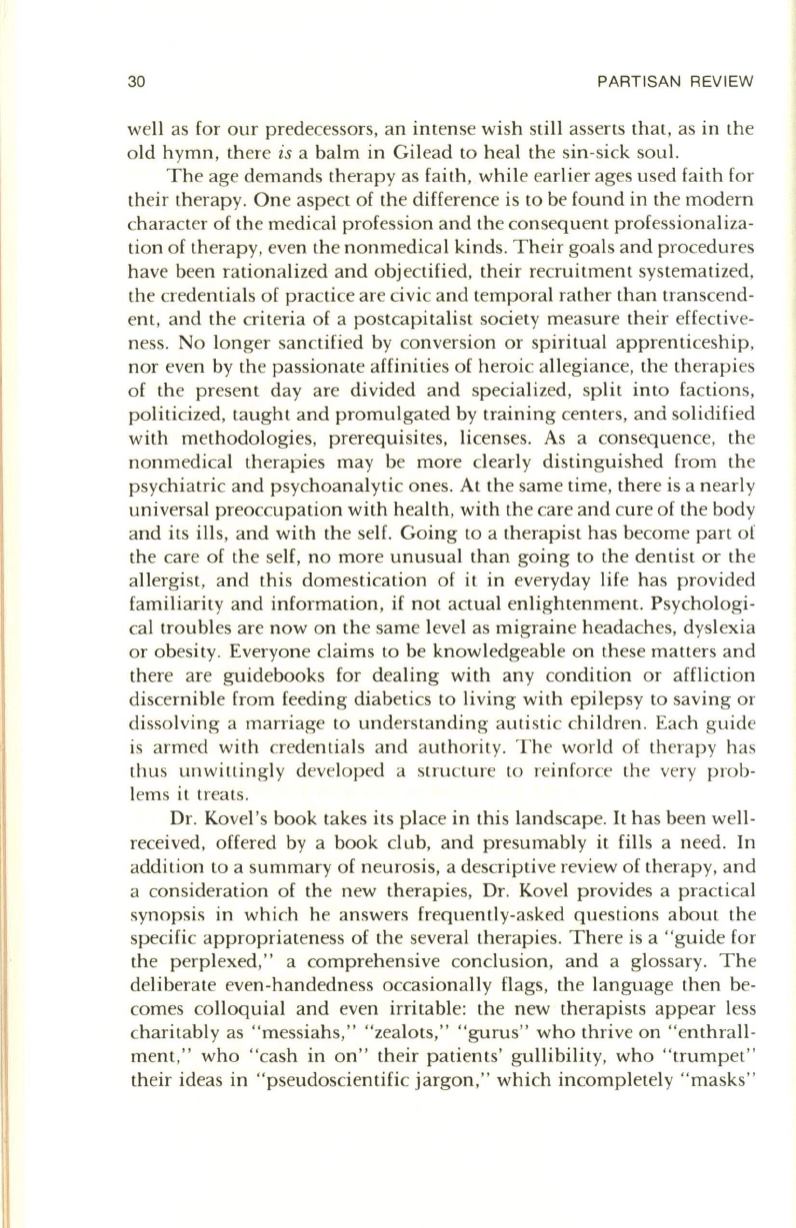
30
PARTISAN REVIEW
well as for our predecessors, an intense wish still asserts that, as in the
old hymn, there
is
a balm in Gilead to heal the sin-sick soul.
The age demands therapy as faith, while earlier ages used faith for
their therapy. One aspect of the difference is to be found in the modern
character of the medical profession and the consequent professionaliza–
tion of therapy, even the nonmedical kinds. Their goals and procedures
have been rationalized and objectified, their recruitment systematized,
the credentials of practice are civic and temporal rather than transcend–
ent, and the criteria of a postcapitalist society measure their effective–
ness. No longer sanctified by conversion or spiritual apprenticeship,
nor even by the passionate affinities of heroic allegiance, the therapies
of the present day are divided and specialized, split into factions,
politicized, taught and promulgated by training centers, and solidified
with methodologies, prerequisites, licenses. As a consequence, the
nonmedical therapies may be more clearly distinguished from the
psychiatric and psychoanalytic ones. At the same time, there is a nearly
universal preoccupation with health, with the care and cure of the body
and its ills, and with the self. Going to a therapist has become part of
the care of the self, no more unusual than going to the dentist or the
allergist, and this domestication of it in everyday life has provided
familiarity and information, if not actual enlightenment. Psychologi–
cal troubles are now on the same level as migraine headaches, dyslexia
or obesity. Everyone claims to be knowledgeable on these matters and
there are guidebooks for dealing with any condition or affliction
discernible from feeding diabetics to living with epilepsy to saving or
dissolving a marriage
to
understanding autistic children. Each guide
is armed with credentials and authority. The world of therapy has
thus unwittingly developed a structure to reinforce the very prob–
lems it treats.
Dr. Kovel's book takes its place in this landscape. It has been well–
received, offered by a book club, and presumably it fills a need. In
addition to a summary of neurosis, a descriptive review of therapy, and
a consideration of the new therapies, Dr. Kovel provides a practical
synopsis in which he answers frequently-asked questions about the
specific appropriateness of the several therapies. There is a "guide for
the perplexed," a comprehensive conclusion, and a glossary. The
deliberate even-handedness occasionally flags, the language then be–
comes colloquial and even irritable: the new therapists appear less
charitably as "messiahs," "zealots," "gurus" who thrive on "enthrall–
ment," who "cash in on" their patients' gullibility, who "trumpet"
their ideas in "pseudoscientific jargon," which incompletely "masks"


